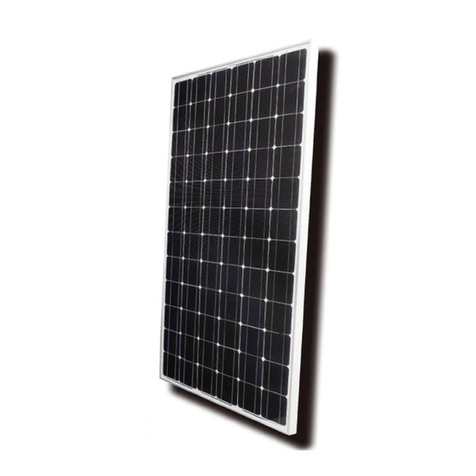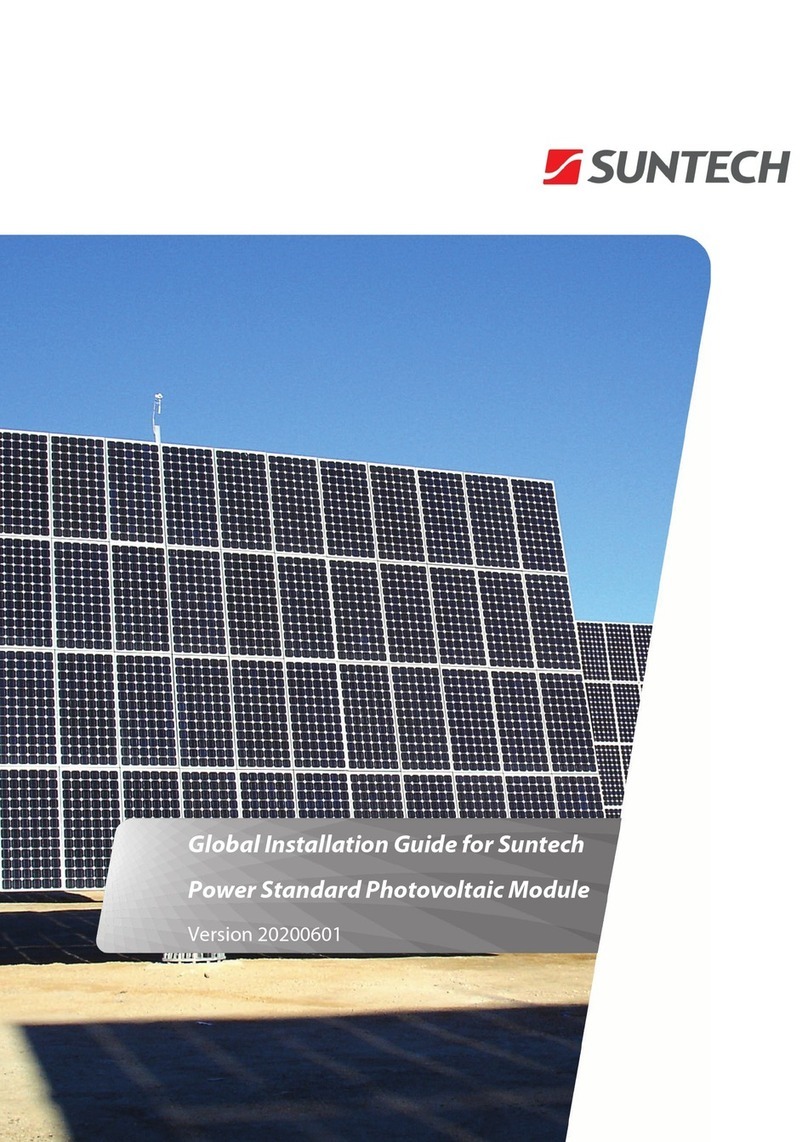Purpose of this guide
Handling safety
• Do not lift the module by grasping the module’s junction box or electrical leads.
• Do not drop the module or allow objects to fall on the module.
• Do not place any heavy or sharp objects on the module.
• Be cautious when placing the module down onto a surface, particularly when
placing it in a corner.
• Inappropriate transport and installation may break the module and void the
warranty.
• Do not attempt to disassemble the modules, and do not remove any attached
nameplates or components from the modules.
• Do not apply paint or adhesive to the module top surface or backsheet.
• To avoid damage to the backsheet and cells, do not scratch, dent or hit the
backsheet. During the transportation, do not to apply direct pressure on the backsheet
or front glass.
• Do not drill holes in the frame. This may compromise the frame strength, cause
corrosion of the frame and void the warranty.
• Do not scratch the anodized coating of the frame (except for grounding
connections at the grounding connection point on the back side of the module). It may
cause corrosion of the frame or compromise the frame strength.
• A module with broken glass or torn backsheet cannot be repaired and must not be
used since contact with any module surface or the frame can cause an electric shock.
• Work only under dry conditions, and use only dry tools. Do not handle modules
under wet conditions unless wearing appropriate protective equipment.
• When storing uninstalled modules outdoors for any period of time, always cover
the modules and ensure that the glass faces down on a soft flat surface to prevent
water from collecting inside the module and causing damage to exposed connectors.
No.3
• Only use equipment, connectors, wiring and support frames suitable for solar
electric systems.
• Do not use mirrors, other magniers or antically concentrated sunlight onto the
modules.
• Always use fall protection equipment when working from heights of 6 feet (183cm)
or above. Follow Occupational Safety and Health Act (OSHA) or local governing safety
regulations regarding Fall Protection. (UL Only)
• Do not sit, stand, step or walk on any side of the module, including the frames.
• Do not permit any part of the module(s) to be submerged or allow for constant
water to soil the module(s) unless it's natural rain fall or periodic cleaning.
Purpose of this guide
• This guide contains information regarding the installation and safe handling of
Wuxi Suntech Power Co., Ltd photovoltaic module (hereafter referred to as “module”).
Wuxi Suntech Power Co., Ltd referred to as“Suntech”.
• Installers must read and understand this guide prior to installation. For any
questions, please contact Suntech's Global Quality & Customer Support department or
our local representatives for more detailed information. Installers must follow all safety
precautions as described in this guide as well as local requirement and regulations by
law or authorised organisations.
• Before installing a solar photovoltaic system, installers should familiarize
themselves with its mechanical and electrical requirements. Keep this guide in a safe
place for future reference (care and maintenance) and in case of sale or disposal of the
modules.
• Suntech modules are tested and certified for installation worldwide. Different
regions may have dierent regulations for solar PV installations. In this guide, hereafter
"IEC Only" is used to refer to regions where IEC standard applies, e.g. Europe, Middle
East, most of Asia Pacific countries; " UL Only " is used to refer to regions where UL
standard applies, e.g. United States, Canada; all other references are global.
General safety
• Modules that fall under this application class may be used in system operation
at more than 50V DC or 240W, where general contact access is anticipated. Modules
qualied for safety under IEC 61730-2 and within this application class are considered
to meet the requirements for Safety Class II. (IEC Only)
• Installing solar photovoltaic systems requires specialized skills and knowledge.
Installation must only be performed by qualied personnel.
• Installers must assume all risks of injury that might occur during installation,
including, but not limited to, the risk of electric shock.
• One single module may generate more than 30V DC when exposed to direct
sunlight. Contact with a DC voltage of 30V or more is potentially hazardous.
• Do not disconnect under load.
• PV modules generate electricity when exposed to sunlight. Number of modules
string connected can cause lethal shock and burn hazards. Only authorized and trained
person should have access to the modules.
• Photovoltaic solar modules convert light energy to direct current electrical energy.
They are designed for outdoor use. Modules can be ground mounted, mounted on
rooftops, vehicles or boats. The proper design of support structures lies within the
responsibility of the system designers and installers.
• When installing the system, abide to all local, regional and national statutory
regulations. Obtain a building permit if necessary.
• The electrical characteristics are within ±10 percent of the indicated values of
Isc, Voc and Pmax under standard test conditions (irradiance of 1000 W/m², AM 1.5
spectrum, and a cell temperature of 25°C (77°F) ).
No.2






























